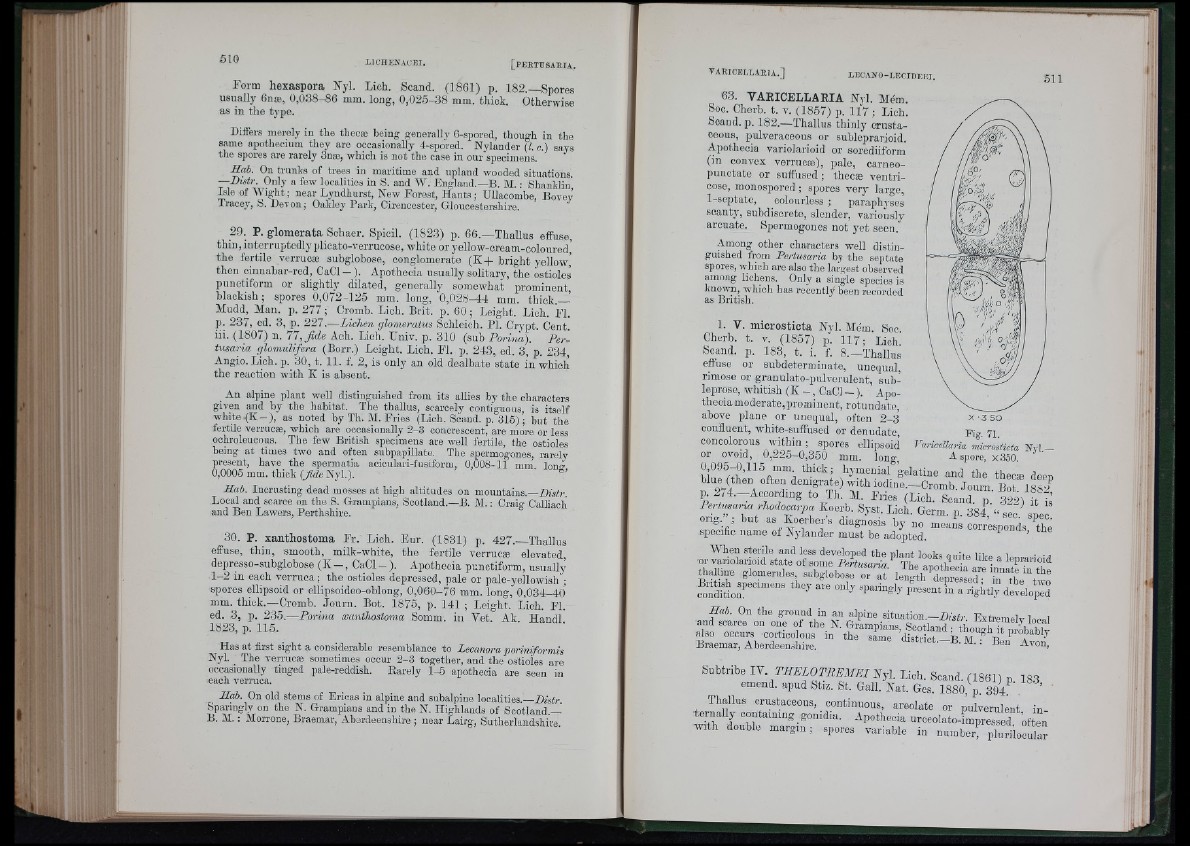
i ’i! I
Z S
Form hexaspora Nyl. Lich. Soand. (1861) p. 182.—Spores
usually 6næ, 0,0 3 8 -8 6 mm. long, 0 ,0 2 5 -3 8 mm. thick. Otherwise
as in the type.
Differs merely in the thecæ being generally G-spored, though iu the
same apothecium they are occasionally 4-spored. Nylander (I. c.) says
the spores are rarely 3næ, which is not the case in our'specimens.
Hab. On trunks of trees in maritime and upland wooded situations
—Distr. Only a few localities in S. and W. E n g la n d .-B . M. : Shanklin
Isle of \Viglit; uear Lyndhurst, New Forest, Hants; Ullacombe, Bove?
Tracey, S. Devon ; Oakley Park, Cirencester, Gloucestershire.
29. P. glomerata Schaer. Spioil. (1823) p. 66.—Thallus effuse,
th in , interruptedly plioato-verruoose, white or yellow-oream-ooloured,’
th e fertile verruoæ subglobose, conglomerate (K + b r ig h t yellow,’
then cinnabar-red, CaCT-). Apotbecia usually solitary, the ostiole?
punotiform or slightly dilated, generally somewhat prominent
b lack ish ; spores 0 ,0 7 2 -1 2 5 mm. long, 0 ,0 2 8 -4 4 mm. thiok —
Mudd, Man. p. 277 ; Cromb. Liob. Brit. p. 60 ; Leight. Lich. Fl.
p. 237, ed. 3, p. 2 2 7.— Lichen glomeratus Sohleicb. PI. Crypt. Cent,
iii. (1807) n. 77, fid e Ach. Lich. Univ. p. 310 (sub Porina). Pertusaria
glomulifera (Borr.) Leigbt. Liob. F l. p. 243, ed. 3, p. 234,
Augio. Licb. p. 30, t. 11. f. 2, is only an old dealbate s ta te in which
the reaction witb Iv is absent.
An
alpine plant well distinguisbed from its allies by the characters
given
J, and by the habitat. The thallus, scarcely contiguous, is itself
white (K - ) , as noted by Th. M. Fries (Lich. Scand. p. 315) ; but the
fertile verrucæ, which are occasionally 2-3 concrescent, are more or less
ochroleucous. The few British specimens are well fertile, the ostioles
being a t times two and often subpapillate. The spermogones, rarely
present, have the spermatia aciculari-fusiform, 0,008-11 nun Ion»
0,0005 mm. thick ( / * Nyl.).
Hab. Incrusting dead mosses at high altitudes on mountains. Distr.
Local and scarce ou the S. Grampians, Scotland.—B. M. : Crai» Calliach
and Ben Lawers, Perthshire. °
30. P. xanthostoma F r. Lich. E u r. (1831) p. 427.—Thallus
effuse, th in , smooth, milk-white, th e fe rtile verrucæ elevated,
de jesso -su b g lo b o se (K - , CaCl - ). Apothecia punotiform, usually
1 -2 in each verruca ; th e ostioles depressed, pale or pale-yellowish ;
spores ellipsoid or ellipsoideo-oblong, 0,060-76 mm. long, 0,034-4o’
mm. th ic k .-C rom b . Jo u rn . Bot. 1875, p. 141 ; Leight. Licb. Fl.
ed. 3, p. 235.—Poi-ina xanthostoma Somm. in Vet. Ak. Han d l
1823, p. 115.
^ H as a t first sight a considerable resemblance to Lecanora poriniformis
Nyl. ^ The verrucæ sometimes occur 2-3 together, and the ostioles are
occasionally tinged pale-reddish. Rarely 1-5 apothecia are seen iu
each verruca.
Hah. On old stems of Ericas in alpine and subalpine localities.—Disfr
S/aringly on the N. Grampians and in the N. Highlands of Scotiand.-ri
B. M. : Morrone, Braemar, Aberdeenshire ; near Lairg, Sutherlandshire.
511
63. VARICELLARIA Nyl. Mém.
Soo. Cherb. t. v. (1857) p. 117 ; Lich.
Soand. p. 182.—Thallus thinly criista-
oeous, pulveraceous or subleprarioid.
Apothecia variolarioid or sorediiform
(in convex vornioæ), pale, oarneo-
piiiiotate or suffused ; theoæ ventri-
cose, monospored ; spores very large,
1-septatc, colourless ; paraphyses
scanty, subdiscreto, slender, variously
arcuate. Spermogones not jæ t seen.
Among other characters well distinguished
from Pertusaria by the septate
spores, which are also the largest observed
among lichens. Only a single species is
known, which has recently been recorded
as British.
1. V. microsticta Nyl. Mém. Soo
Cherb. t. v. (1857) p. 1 1 7 ; Lioh.
Scand. p. 183, t. i. f. 8 .—Thallus
effuse or subdeterminate, unequal,
rimose or granulato-pulverulent, sub?
leprose, whitish (K - , CaCl - ). Apotheoia
moderate, prominent, rotundate,
above plane or unequal, often 2 - 3 x -3 S 0
confluent, W'hite-suffused or denudate,
Pig. 71.
concolorous ivithin ; spores ellipsoid
Varicellaria microsticta Nyl._
or ovoid, 0 ,2 25-0,350 mm. long,
A spore, x350.
0,0 9 5 -0 ,1 1 5 mm. th ic k ; hymenial »plntine nn<l ii, i
blue (then often denigrate) w ith io d in e .-C rom b . Jo u rn B ^ ® i Ì ?
p. 2 /4 .—According to Th. M. Fries (Licb Scaud n ' 8991 > ’
P e r tu sa rJ rh o d o ^ rp a Ivoerb. Syst. Licb. G em . p. 384 “ sm spec'
orig. ; b u t as Ite e rb o rs diagnosis by no means corresponds the
specific name of Kylander must be adopted.
p i... lool. ,uta ,i,„ .
thalliue glomerules, snboloboi oi l e Z b T
S S o r “ “*>■ “ •
also occurs corticolous in tbe same d istric Braemar, Aberdeenshire. mstiictt.——DD. MM. ;¿ BRe n’ AV von",
Subtribe l Y .T H E L ( J R E M E I N y l . Lich. Scand. (1861) p 183
emend, apud Stiz. St. Gall. Nat. Ges. 1880, p. 394
Thallus crustaceous, continuous, areolate or p’ulverufont in
wvTitbh JdoouZbll e m arg in ; spores '^ Pva®ritahbelec iaiuur eneuomlabteor- L pplruersi So’ocfutleanr